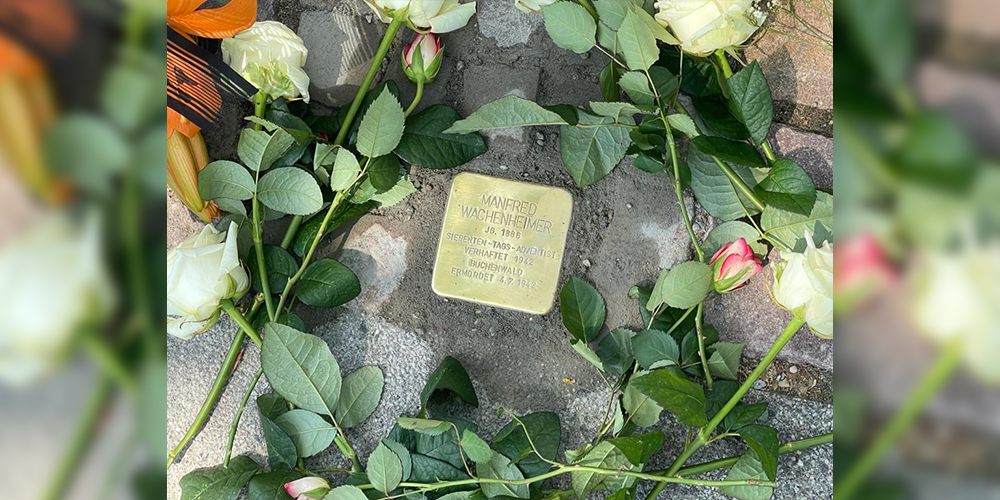Move is part of a drive to review the church’s failures during National Socialist rule.

The Seventh-day Adventist church in Leipzig inaugurated a memorial plaque to remember church member Manfred Wachenheimer. The small commemorative plaque honors Wachenheimer, an Adventist of Jewish ancestry, murdered at the Buchenwald concentration camp in 1942.
Born in Karlsruhe in 1886, Wachenheimer spent his childhood and youth there. Later he worked as a merchant and correspondent in several companies. He eventually moved to Leipzig. In 1934, he married his wife, Maria (née Hass).
According to a report by Dieter Wache in the August issue of the church magazine Adventisten heute, Wachenheimer was unemployed from 1933 to 1939 because of his Jewish ancestry. On February 4, 1939, he was imprisoned for 10 days for not wearing the Jewish star and had to do forced labor.
Murdered by Poison Injection
During his time in Leipzig, Wachenheimer came into contact with the Adventist Church and became a Seventh-day Adventist. His wife also stated after 1945 that she was an Adventist. At the insistence of individual parishioners, Wachenheimer was expelled from the Adventist church in Leipzig. It was claimed that this step was only “pro forma” to comply with state regulations. Wachenheimer continued to attend church services. When he was also denied this, Hermann Kobs, the congregation’s pastor, intervened. As a result, he, too, was denounced by his community.
The Gestapo imprisoned Kobs on March 18, 1942. He remained in prison until April 7, 1942, and was subsequently conscripted with other prisoners. He met Wachenheimer again. Kobs was suspended from his ministry as a pastor in Leipzig. Local Adventist leaders initiated the dismissal, which was declared — according to the official explanation — a “precautionary measure.”
On March 21, 1942, Wachenheimer was ordered to be taken into custody by the Leipzig Gestapo. The reason given was his illicit religious activities, since he had participated in the church service as a “non-Aryan” among “Aryan people.” On June 4, 1942, he was taken to the concentration camp in Buchenwald. There he died on July 4 at 7:55 a.m. from a yellow cross poison gas syringe.
In 2012, after coming to terms with the history of Seventh-day Adventists during the Nazi regime, members of the Adventist church in Leipzig had the idea of setting up a memorial for Wachenheimer. The project gained momentum thanks to a lecture by church historian Johannes Hartlapp, lecturer at Friedensau Adventist University near Magdeburg. Hartlapp also provided the congregation with copies of helpful documents. The memorial plaque was inaugurated in front of the church building on June 16, 2021.
Historical Background
In November 1933, the Seventh-day Adventist community was banned by the Gestapo in Prussia, Hesse, Saxony, and other regions. Although the ban was lifted in December of that year, from January 1934 Adventist churches began to be increasingly monitored by the police.
In his 684-page book Siebenten-Tags-Adventisten im Nationalsozialismus (Seventh-day Adventists under National Socialism; V & R Unipress, 2008), Hartlapp wrote, “From then on, fear determined all further decisions…. The community as a whole was thus — in the terminology of National Socialism — largely aligned. It soon became apparent that there were individuals who opposed this trend and, regardless of the consequences, could not or did not want to take part in the course correction.”
“Community members like Alexander Mannesmann belonged to the Seventh-day Adventists who later felt the brutal power of the state and had to accept the loss of their job or imprisonment for their testimony of faith,” Hartlapp wrote. Because of their attitude, for example, Emil Biegmann was killed in the Dachau concentration camp and A. Eschrich in the Buchenwald concentration camp. Two Adventist conscientious objectors, Franz Partes and Franz Dlugosch, are also known to have paid for their position with death.
Hartlapp also recalls two Adventist pastors who paid for their words with their lives: Rudolf Harress from Oldenburg died on July 6, 1942, in the Gross-Rosen concentration camp near Breslau, and Rudolf Schäfer was killed in February 1945 in a prison in Dresden. But “everyone who resisted any form of adaptation and thus ‘conformity’ within their own church suddenly found themselves largely alone,” Hartlapp wrote.
Declaration on the Nazi Era
In a joint declaration on the 60th anniversary of the end of World War II in 2005, Seventh-day Adventists in Germany and Austria took a stand on the behavior of the Seventh-day Adventist Church during the Nazi era. It lamented that Adventists were also “involved in this terrible war.”
The character of the Nazi dictatorship was not recognized in time nor clearly enough. Adventist publications contained statements “that paid homage to Adolf Hitler and expressed the racist ideology of anti-Semitism in a way that is incomprehensible from today’s perspective.” Germans and Austrians had become “accomplices of racial madness”; “many Seventh-day Adventists” had “taken no part in the need and suffering of their Jewish fellow citizens.”
“We are guilty of our failure toward the Jewish people, all those persecuted and those affected by the war, and also toward Adventists in other countries,” the official statement said. “We, as Seventh-day Adventists, did not act courageously and consistently in those times, despite our knowledge of Scripture and the prophetic Word, and thus failed to follow our Lord.” Adventists did not follow those “who bravely resisted in our ranks and neither bowed to the Nazi dictatorship nor made common cause with it.”
In the statement, the Adventist Church said that the past should not be forgotten, and obedience, which “we owe to the state authorities, should not lead to the abandonment of biblical convictions and values.” It is important to confess the faith courageously and to live it consistently “when we for our part get into the ‘hour of temptation.’ ”
The original version of this story was posted by Adventistische Pressedienst.








